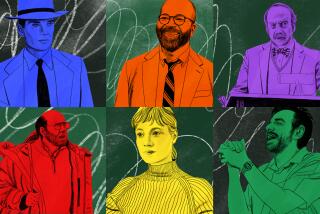Teacher’s year on front lines
- Share via
In the classes I took to become a teacher, the elementary crowd sat on one side of the room, trimming bright, crafty-looking construction paper cutouts. They were a different breed: nicer and artier, but also less intellectually serious. Or so many of us prospective high school teachers thought.
If we had read “Welcome to the Aquarium,” we might have thought differently. The book is veteran kindergarten teacher Julie Diamond’s exploration of one year in the life of K-104, a class in New York City’s public school system.
Some of the book occasionally gets lost in abstract, theoretical musings. Usually, however, Diamond’s attacks are specific and pointed, bringing up issues -- such as lock-step “scripted lessons” -- that concern anyone who cares about education.
Appropriately enough for someone who believes asking the right questions is more valuable than having the right answers, Diamond ends up with burning queries about the purpose of education.
She is particularly taken by the Reggio Emilia approach, which appeared as an antidote to fascism in Northern Italian preschools after World War II. Based on developing the emotional as well as the educational life of the child, it’s built on the contributions of parents and community members. Instead of tests, there are projects -- books, charts, installations -- created by teams of children.
A proponent of a flexible curriculum, Diamond states plainly she doesn’t really care if students can read or write by the end of kindergarten (though most do). To her, kindergarten is about building up a curiosity about the world and analyzing it, preparing students to care about learning.
So it’s no surprise that Diamond is sometimes infuriated by new trends in education. She describes how her kindergartners’ legs shake as they take a standardized test -- the fact that the test kit comes with a cheery puppet who is supposed to spout the questions makes the scenario even more horrifying.
But the real horror comes from above, a cold educational system. Administrators throw out classroom bookshelves built by a carpenter parent because they are not standard issue (of course, there are no funds to replace the tossed shelving). Mandated Orwellian learning standards posted on the walls alienate children.
As depressing as her critique on the system is, most of the book is a primer of the best kind of practices. The case study of a boy named Henry is riveting. A puzzling, quiet child who won’t play with others, Henry slyly unscrews the classroom easel and sabotages other kids, at one point spitting on another child’s food. Annoyed, Diamond quickly labels him “sneaky.”
She then really looks at him and his behavior, talking to his parents (disastrously at first), and trying to understand what Henry is trying to say through his actions. Realizing that the labeling created a roadblock in her dealings with him, she begins to ask herself questions. It’s more season finale of “The Wire” than Hollywood ending: Henry becomes an active part of the class, but his future in more traditional classrooms is uncertain at best.
Interestingly, there is no talk of discipline and consequences, the prime topic of discussion among teachers. My guess is that Diamond feels that when teachers listen to students, when projects appeal to students’ interests, when classroom rituals are well taught, discipline is not a problem. And there are a few problems with Diamond’s ideas. Trust is something she brings up again and again -- teachers need to trust children, administrators need to trust teachers. But this isn’t always the case.
Still, this is a look at what happens in the sometimes confused but creative, passionate, determined mind of a teacher. She has captured the world of the class -- at times chaotic, always busy, usually inspired. All kids deserve a learning world like this one.
--
Scribner is a Los Angeles-area writer.
More to Read
Sign up for our Book Club newsletter
Get the latest news, events and more from the Los Angeles Times Book Club, and help us get L.A. reading and talking.
You may occasionally receive promotional content from the Los Angeles Times.









